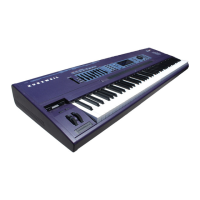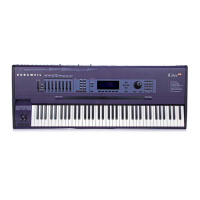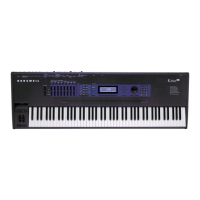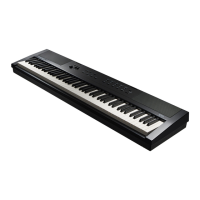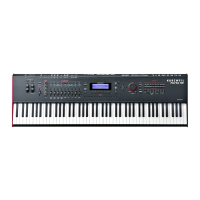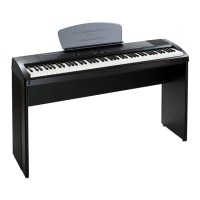Advanced KDFX
Using the Algorithms
15-47
CentrAtten (Attenuation) (AutoPan) is the amount the signal level drops as it is panned through
the center of the stereo image. For the smoothest tracking, a widely accepted subjective reference
is -3dB. Values above -3dB will cause somewhat of a bump in level as an image passes through
the center, while values below -3dB will cause a dip. Range is -12 to 0 dB.
Depth (Tremolo) controls the amount of attenuation applied when the LFO is at its deepest
excursion point. Range is 0 to 100%.
LFO Phase (Tremolo BPM) shifts the phase of the tremolo LFO relative to the beat reference. It is
most useful when Tempo is set to System. Range is 0.0 to 360.0 degrees.
50% Weight (Tremolo) is the relative amount of attenuation added when the LFO is at the -6dB
point. This causes the LFO shape to bow up (positive values) or down (negative values). Range
is -16 to 3 dB.
L/R Phase sets the phase relationship of the channels. In ßips the left channelÕs LFO out of
phase, with the result that the effect turns into an auto-balancer. Out leaves the left LFO alone.
Pitch Shifter (Pitcher)
Pitcher shifts the pitch of the incoming signal to the speciÞed note.
Pitch is the fundamental pitch imposed upon the input, in MIDI note numbers from C -1 to G 9.
Ptch Offst is an offset from the pitch frequency in semitones, from -12.0 to 12.0. It can be useful
to assign pitch bend or a continuous controller to this parameter through an FXMod.
Odd Wts, Pair Wts, Quartr Wts, Half Wts are parameters that control the exact shape of the
frequency response of Pitcher. An exact description of what each one does is, unfortunately,
impossible, since there is a great deal of interaction between them. For more information and
examples, see the algorithm documentation.
Ring Modulation
Ring modulation multiplies two signals (the ÒcarrierÓ and the ÒmodulatorÓ) together to produce
unusual, often nonharmonic, overtones. The Ring Modulator algorithm in KDFX has two
modes: L*R, in which two mono signals are modulated together; and Osc, in which the input is
stereo, and it is modulated with the sum of Þve waveforms which are generated within the
algorithm itself. Four of these are sine waves, and one (Oscillator 1) has a conÞgurable
waveform.
Wet/Dry: In L*R mode, the left signal is passed dry through this control.
Mod Mode selects between the two modes.
Osc1 Lvl is the level of Oscillator 1, from 0 to 100%.
Osc1 Freq is the frequency of Oscillator 1, from 16 to 25088 Hz.
Osc1 Shape is the waveshape of Oscillator 1, selectable from Sine, Saw+, Saw-, Pulse, and Tr i.
Osc1PlsWid (Pulse Width). When Osc1 Shape is set to Pulse, this sets the pulse width as a
percentage of the waveform period. When the width is set to 50%, the result is a square wave.
This parameter has no effect if other waveform types are chosen. Range is 0 to 100%.
Osc1Smooth smooths (removes the higher harmonics from) the Saw+, Saw-, and Pulse
waveforms. A Sawtooth wave looks more like a triangle wave, and a Pulse wave looks more like
a sine wave. Range is 0 to 100%.
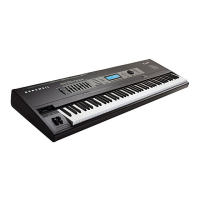
